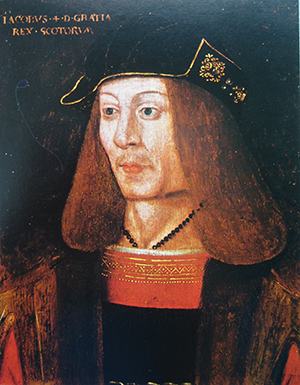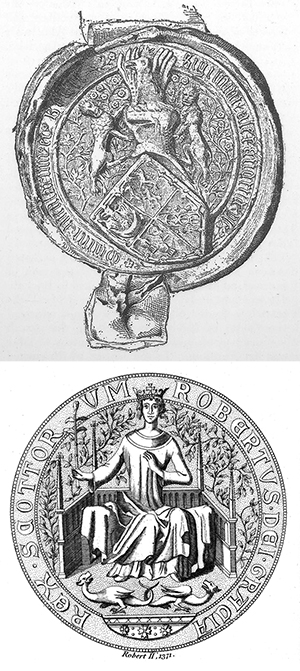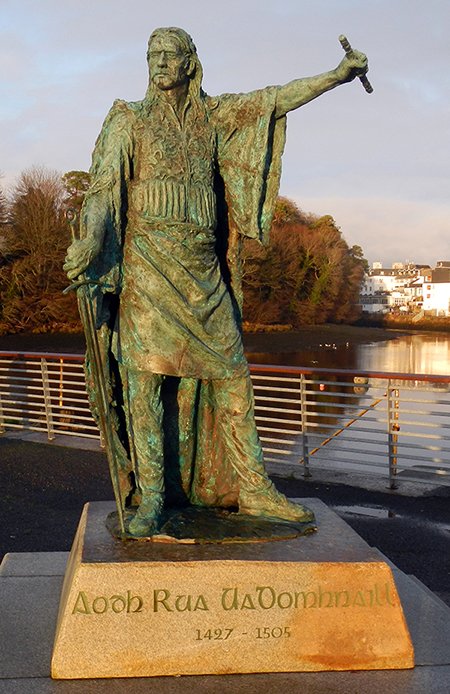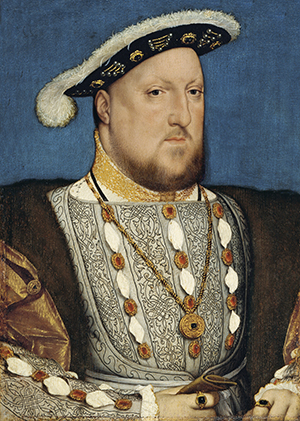James IV, the O’Donnells of Tyrconnell and the road to Flodden
Published in Early Modern History (1500–1700), Features, Issue 6 (November/December 2016), Volume 24THE IRISH CONTEXT OF A SCOTTISH DISASTER
By Simon Egan

Above: James IV of Scotland—killed on 9 September 1513 at Flodden field in Northumbria, where his army of 30,000 was decimated by a smaller English force led by Thomas Howard, earl of Surrey. Little attention has been paid to the broader Gaelic dimension underpinning James’s Flodden campaign.
Over the course of the later Middle Ages the wider Gaelic world, or Gaeltacht, came to encompass nearly 50% of the British Isles. Despite this profound geopolitical recasting of much of late medieval Britain, the broader impact of the Gaelic resurgence has featured little in the historiography of late medieval Ireland, England and Scotland. A case-study of Flodden is useful as it allows for a thematic overview of how the Stewart monarchy, during the late fifteenth and early sixteenth centuries, was able to draw upon considerable support from the Gaelic world, support which in turn could be used against England.
The origins of the O’Donnell–Stewart alliance
Over the course of the late fifteenth century the O’Donnells of Tyrconnell established themselves as one of the most powerful Gaelic dynasties within the wider Irish Sea world. Under the leadership of Aedh Ruadh (d. 1505) and his son, Aedh Dubh (d. 1537), the O’Donnells created a large hegemonic empire spanning much of Ulster, Connacht and north Leinster. The strategic position of the O’Donnell lordship on the north-west coast of Ireland, coupled with their ability to command considerable military and maritime resources, made them ideal allies for the Stewart monarchs. On one level the O’Donnells served as a counter-balance to the MacDonald lordship of the Isles. During the fourteenth century the lordship of Clan Donald emerged as a powerful autonomous force in western Scotland. Holding lands on both sides of the North Channel, in Antrim and the Hebrides, and often courted as allies by the Plantagenet monarchs of England, the lords of the Isles posed a significant threat to Scotland’s western seaboard.
The O’Donnell–Stewart alliance largely derived from this geopolitical situation, and connections between the O’Donnells and the Stewarts can be traced to the late fourteenth century. It is important to note that the earlier Stewart monarchs, Robert II (d. 1390) and Robert III (d. 1406), were highly attuned to the cultural and political nuances of the Gaelic world. Originally hailing from the west coast of Scotland, these kings enjoyed considerable support from the Gaelic Scottish nobility, their chief supporters including the Campbells of Argyll and the Clan Donnchaidh of Atholl. These cultural and dynastic ties with Gaelic Scotland provided the Stewarts with a bridge into Gaelic Ireland, with which they could encircle Clan Donald. Source material relating to Hiberno-Scottish connections for this period is often infuriatingly fragmentary. Nonetheless, it does appear that Clan Donald became increasingly concerned about the Stewart monarchy’s influence with the O’Donnells during the first half of the fifteenth century. This is perhaps most obvious during the reign of James I (d. 1437).
Returning to Scotland in 1424 after eighteen years of captivity in England, James sought to establish strong personal rule over his kingdom. Following the forfeiture and destruction of his kinsmen, the Albany Stewarts who ruled Scotland during his absence, James turned his attention westwards. During the first two decades of the fifteenth century Clan Donald had expanded their territory across much of northern Scotland, most notably in the earldom of Ross. James unsurprisingly sought to reduce their hold on the earldom. Following a series of battles in 1429–31 neither James nor the lord of the Isles, Alexander (d. 1449), was able to gain the upper hand. Based on evidence contained in Scottish and English chronicles and other governmental sources, it appears that James sought assistance from the then lord of Tyrconnell, Niall Garbh O’Donnell (d. 1439).
In 1433 Niall Garbh moved eastwards against the MacDonald lands in Antrim. Alexander and his kinsmen in Antrim were quick to act. Allying with Eoghan O’Neill (d. 1455), the lord of Tyrone and the main regional rival of the O’Donnells, Alexander routed Niall Garbh’s force in east Ulster before launching a two-pronged attack on Tyrconnell. Eoghan’s force marched into Tyrconnell while Alexander’s fleet landed at Inishowen. In the face of overwhelming numbers the O’Donnells were soon defeated. The hegemony that Niall Garbh had built across Ulster and Connacht collapsed shortly afterwards in favour of the resurgent O’Neills. With his Irish option exhausted, James I had little choice but to make peace with Alexander; by 1436 the king had elevated Alexander to the coveted earldom of Ross, acknowledging Alexander’s dominance in northern Scotland. For the next few decades Clan Donald remained pre-eminent in the west, while the O’Neills emerged as the main power in Ulster. It is perhaps unsurprising that Edward IV of England (d. 1483) viewed both of these factions as potential allies for their ability to bolster English influence in regions where it was effectively non-existent.

Above (Top): The seal of Robert II of Scotland (d. 1390). He and his successor, Robert III (d. 1406), were highly attuned to the cultural and political nuances of the Gaelic world and enjoyed considerable support from the Gaelic Scottish nobility.
———————————————————————–
Above: The seal of Alexander MacDonald, lord of the Isles. In the struggle against him in the 1430s, James I of Scotland sought assistance from the lord of Tyrconnell, Niall Garbh O’Donnell (d. 1439). Alexander prevailed and was elevated to the earldom of Ross in 1436, and the O’Donnell hegemony in Ulster and Connacht collapsed.
Matters changed in 1461 when Niall Garbh’s son, Aedh Ruadh, seized power within Tyrconnell. A highly skilled politician and military commander, Aedh Ruadh was the mastermind behind the remarkable O’Donnell recovery. An alliance with the Clandeboy O’Neills drew the Tyrone O’Neills’ attention away from west Ulster, enabling Aedh Ruadh to lead a number of successful military hostings into Connacht. Over the course of the 1460s Aedh Ruadh rebuilt his father’s old alliance network, scoring a number of victories over the Burkes of Clanrickard, the O’Connors of Sligo and the O’Briens of Thomond, as well as propping up the Burkes of Mayo and the O’Connor Ruadh kindred in Roscommon. By 1474 Aedh Ruadh had made peace with the O’Briens, marrying Fionula O’Brien, daughter of the clan chief, Connor. The shifting balance of power in the west of Ireland formed the basis for further expansion into north Leinster. In 1475 Aedh Ruadh marched eastwards, launching a devastating attack on the Pale and forcing ‘black rent’ (tribute) from Dundalk.
Similar developments were occurring in Scotland. Since the late 1460s the Scottish crown had pursued increasingly aggressive policies against Clan Donald. Through the promotion of loyalist kindreds such as the Campbells of Argyll, James III (d. 1488) hoped to break the power of the island lords. The inability of John MacDonald (d. 1503), the fourth and last lord of the Isles, to control his kinsmen weakened the cohesion of Clan Donald and allowed James III to declare the earldom of Ross forfeit in 1475. The political disintegration of the lordship soon followed: various island kindreds descended into fractious infighting during the 1480s and early 1490s, while the lordship itself was finally declared forfeit and seized by the Scottish crown in 1493. John, the last lord of the Isles, was forced to surrender himself to royal authority, becoming a crown pensioner of James IV. He died in ignominy in 1503.
The extent to which developments in Ireland played a role in the collapse of the lordship of the Isles remains uncertain. The resurgence of the O’Donnell lordship in the north-west can hardly have been welcomed by Clan Donald, who were becoming increasingly caught on two fronts as the Scottish monarchy pushed westwards. The English government in Dublin were certainly fearful of royal Scottish intervention. In a panicked report sent to Westminster in 1474, the council went as far as to state that James III planned to ‘reduce all thye land to the obeysuance of the king of Scotts’. Though no such invasion occurred, the ascension of the Tudors eleven years later exposed Ireland to a far greater degree of foreign intervention.

Above: Statue of Aedh Ruadh O’Donnell (d. 1505) in Donegal town. He succeeded his father, Niall Garbh, in 1461 and masterminded a remarkable O’Donnell recovery.
In the summer of 1495 Aedh Ruadh travelled to Glasgow. Upon arrival, he was greeted by the young king of Scots, James IV, and both men promptly entered into what the Annals of the Four Masters have dubbed a comhaontu, or alliance. It is very likely that the issue of the Yorkist pretender Perkin Warbeck (d. 1499) was discussed during this meeting. The threat of Yorkist pretenders such as Warbeck (and Lambert Simnel in the late 1480s) struck at the very heart of the fledgling Tudor dynasty. Though little became of this venture, Warbeck had for a time enjoyed the support of James IV, Margaret of Burgundy (d. 1503), the Holy Roman Emperor Maximilian I (d. 1519) and Maurice, earl of Desmond (d. 1520). The fact that Warbeck had been able to move freely in Ireland throughout the 1490s highlighted the severe limitations of Tudor power in Ireland and the potential for foreign meddling therein.
Warbeck’s capture in 1497 and execution in 1499 did little to reduce the security threat posed by developments in Ireland. During this time Henry VII (d. 1509) had grown increasingly suspicious of his Irish lord deputy, Gearóid Mór FitzGerald, eighth earl of Kildare. A known Yorkist sympathiser, Kildare had previously supported Lambert Simnel in 1487. Kildare was arrested in 1495 at the height of the Warbeck crisis but was released after a brief period of captivity in England, returning to office in Ireland in late 1496. He did little to increase the power of the Tudors in Ireland and there is evidence to suggest that he entered some form of league with O’Donnell, placing his second son, Henry (d. 1514), into fosterage with Aedh Ruadh in 1499. Moreover, following Aedh Ruadh’s death in 1505, Kildare maintained this connection with his son and successor, Aedh Dubh. Such was the ineffectiveness of Kildare’s deputyship that by December 1506 Henry was considering leading a full military intervention in Ireland. Only the fatal deterioration of his health prevented him from doing so.

Above: Henry VIII of England—in the run-up to Flodden, James IV of Scotland hoped to take advantage of his absence in France.
Conclusion
Why O’Donnell cautioned against an intervention in Ireland remains uncertain. It is perhaps fair to suggest that both James and O’Donnell were confident that an invasion of England would prove successful. By early September it certainly appeared that the Scots were in the ascendancy and that the English were surrounded on numerous fronts. Henry VIII was bogged down in an unsuccessful invasion of France, while King Louis had provided the Scots with arms, munitions, money and the promise of further aid. French military advisers had been sent to train James IV’s army in the art of Continental pike warfare, while the Scottish navy, one of the most advanced in northern Europe, posed a serious challenge to English sea power. In Ireland, one of the most powerful Gaelic magnates stood poised to assist the Scots. For the first time since Robert Bruce, a Scottish king posed a serious challenge to English power within the British Isles. The O’Donnells had played no small part in this.
Simon Egan is a recent Ph.D graduate in history from University College Cork.
FURTHER READING
S. Boardman, ‘The Gaelic world and the early Stewart court’, in D. Broun & M. MacGregor (eds), Mìorun Mòr nan Gall: ‘The great ill will of the Lowlander’? Lowland perceptions of the Highlands, medieval and modern (Stornoway, 2006).
N. MacDougall, James IV (East Lothian, 1997).
D. MacGettigan, ‘The renaissance and late medieval lordship of Tír Chonaill, 1461–1555’, in W. Nolan, L. Ronayne and M. Dunlevy (eds), Donegal history and society (Dublin, 1995).
K. Simms, ‘Niall Garbh O’Donnell, king of Tír Conaill, 1422–39’, Donegal Annual 12 (1977).
IRISH CHIEFS’ AND CLANS’ PRIZE
IN GAELIC HISTORY 2017
The Standing Council of Irish Chiefs and Chieftains and the Clans of Ireland (Fínte na hÉireann), in association with the History Department of Trinity College, Dublin, and History Ireland magazine, are offering a prize of €500 for the winning entrant in an essay competition on Gaelic Ireland.
Entry is open to all persons over 18 years who are NOT on the academic staff of a history department in any third-level institution.
Essays must be on a topic dealing with any aspect of the political, social or cultural history of Gaelic Ireland (within the date range AD 400–1690), such as Irish kingship, lordship, landholding, genealogy, family history etc. The essay should be approximately 2,000 words in length and accompanied by full footnote references to sources used, with a bibliography at the end (footnotes and bibliography will not be counted as part of the word length). It may be written in English or Irish.
Entries, with candidate’s name, address and contact details, should be emailed (preferably) as an attached MS-Word file to: mksimms@tcd.ie or posted to:
‘Chiefs’ and Clans’ Prize’
c/o Katharine Simms,
History Department,
School of Histories and Humanities,
Trinity College Dublin,
Dublin 2, Republic of Ireland
(To arrive by 1 June 2017)
The prize will only be awarded for an entry deemed to be of publishable standard. Subject to editorial approval, a version of the paper will appear in a subsequent issue of History Ireland. Both the winner and other entrants whose papers are deemed of publishable standard may be invited to contribute their work to a projected volume of essays on Gaelic Ireland, which is a central goal of the Council of Chiefs and Chieftains and Clans of Ireland competition.
For further details, see www.tcd.ie/history/irishclansandchiefsprize.php
















